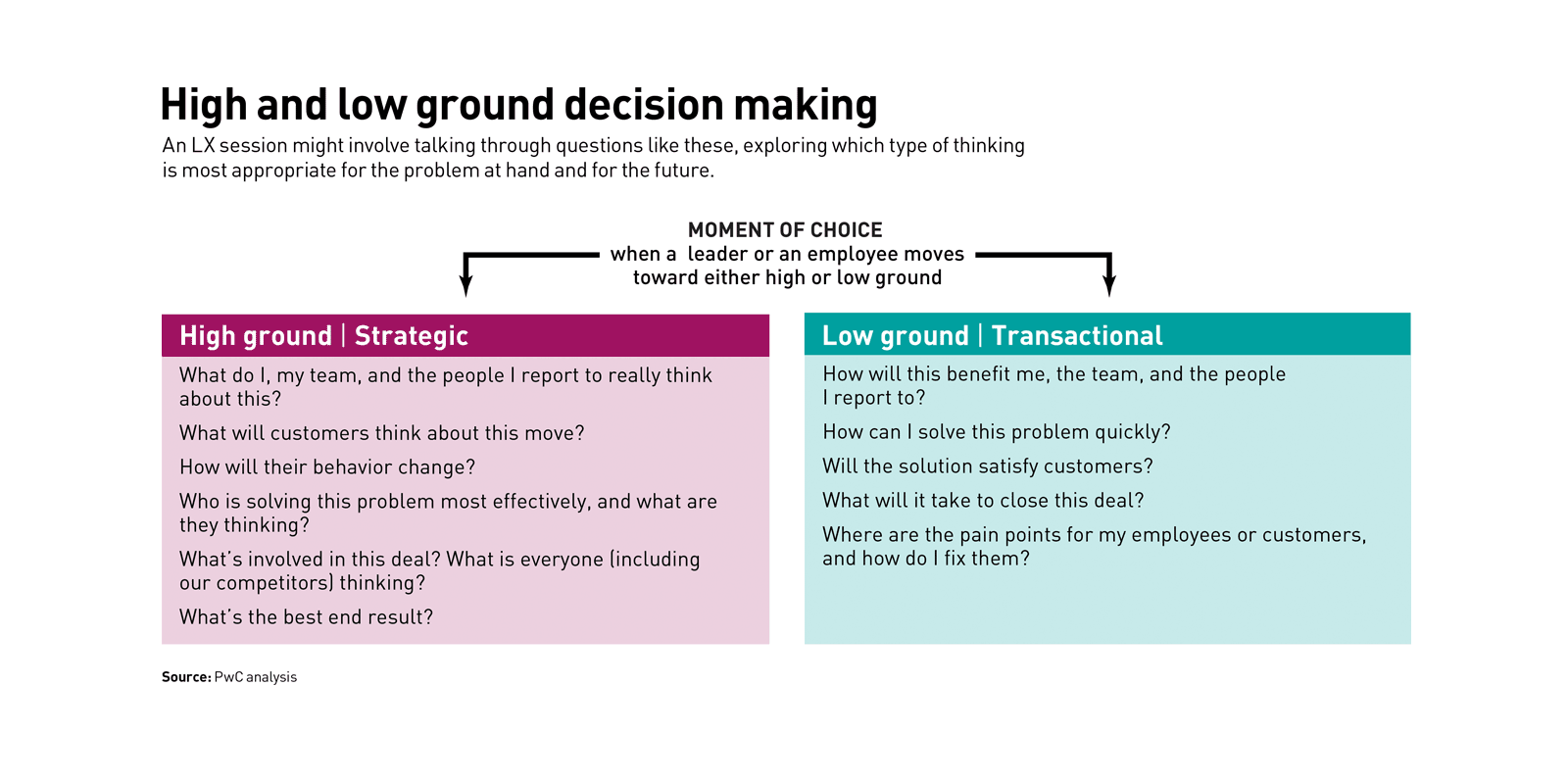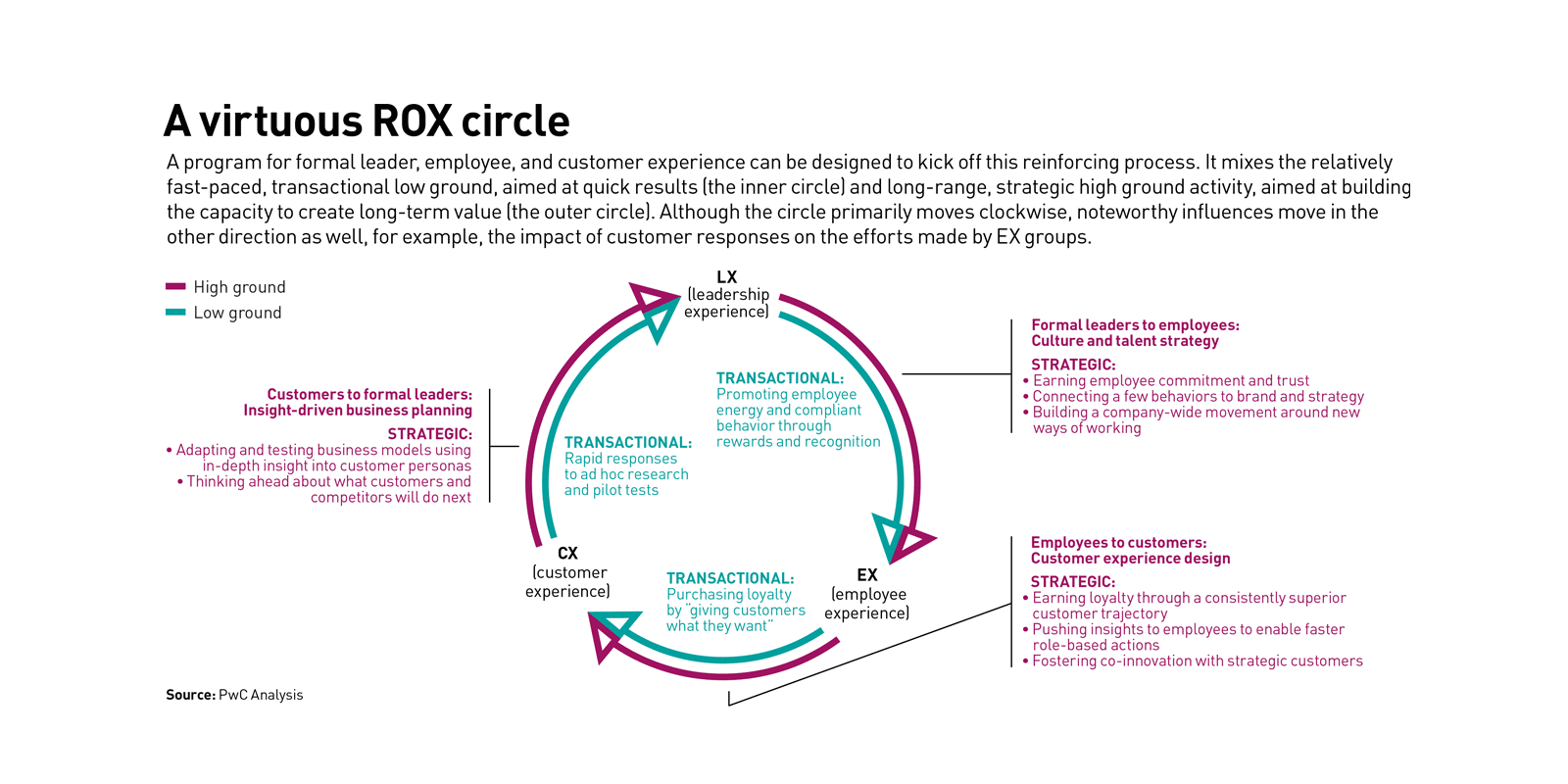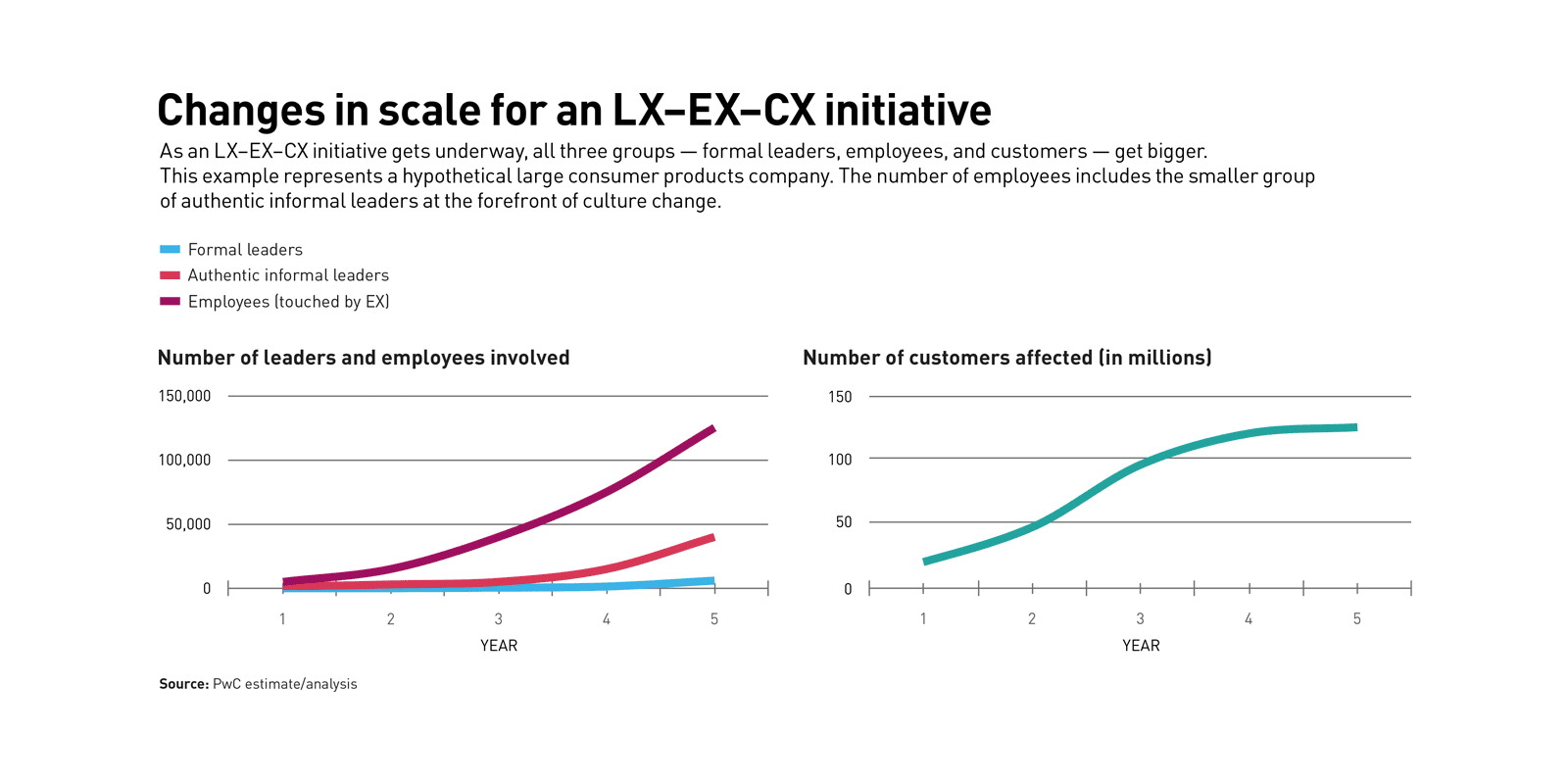ROX3: Boosting returns on leadership, customer, and employee experience
You can transform your company by strengthening the links among all three types of activity.
At one of the world’s most respected manufacturers — a company known for innovation and employee engagement — the CEO was asked recently about his greatest concerns about the enterprise. “We lack leadership capacity,” he said. The company was entering an intensive phase in its quest to become digitally adept, seeking to master new technology, and it had not made enough progress in improving its employees’ skills or connecting with customers through digital channels. “We need our top executives, in particular, to be better at thinking long-term and driving meaningful change.”
The problem, he added, was not so much a lack of technological acumen as a lack of connection between the company’s formal leaders (those with the highest-ranking positions) and their employees and customers. These senior executives needed to demonstrate that they could stay on top of today’s complex challenges. Only then would employees feel confident enough to really invest themselves in the company’s future. The formal leaders also needed to be more skilled at understanding their customers — less focused on giving them what they demanded immediately, and more on recognizing how customers were changing, and what kinds of experiences would make them more loyal. “If we want to really do our best with employees and customers,” the CEO concluded, “we as the top team need to work on ourselves.”
This CEO’s conclusion represents a high-leverage opportunity that is overlooked at many companies. A well-designed leadership experience (LX) — oriented not just to solving issues of strategy and execution, but to addressing the leaders’ own collective development — can be linked to employee experience (EX) and customer experience (CX) in a way that fosters a healthy, productive, emotionally driven commitment among all three groups: leaders, employees, and customers. This, in turn, can forge a stronger identity for the company and set it up for success in the digital age.
Many business leaders are beginning to recognize return on experience (ROX), a concept that we have pioneered at PwC, as a critical way for their companies to create value. They are investing in CX to build customer loyalty, and in EX to improve their culture and transform their workforce. They’ve heard enough stories about experience-obsessed companies such as Southwest Airlines, cleaning products manufacturer Method, or the most innovative healthcare providers, to know that CX and EX are related; emotional engagement among employees tends to produce high customer engagement.
But they need to bring their own leadership experience into the mix. If good CX is a trajectory of appealing touch points and good EX is like a social movement in the way it inspires commitment, then good LX is a catalyst for the rest of the enterprise. What leaders learn has a direct impact on the quality of EX and CX, because everything that senior leaders say and do is amplified throughout the organization as employees respond and comment. Employees pay especially close attention to where those leaders pay attention, and they adjust their own behavior accordingly. In this way, leaders can influence employees to create the kind of company presence that attracts customers.
We call this approach “return on experience cubed,” or ROX3, because the three forms of experience reinforce one another so strongly. A design that aligns LX, CX, and EX can greatly improve all three forms of experience — and can equip the organization for a more effective transformational journey. Indeed, redesigning these three elements together is one of the most effective and scalable ways to influence a company’s culture and shape its future.
The neuroscience of experience
Our understanding of the interrelationship among LX, EX, and CX is still relatively new, but it derives from a number of well-established sources. These include PwC’s deep experience with organizational culture (developed by Jon Katzenbach and his associates at the firm’s Katzenbach Center), workforce transformation (developed through PwC’s “workforce of the future” initiative), digital upskilling (developed with the firm’s ongoing “New world. New skills.” program) and return on experience (pioneered in collaboration with the firm’s Experience Center and in work with the Katzenbach Center’s Reid Carpenter). We also draw on the work of such academic researchers as Carol Dweck, Linda Hill, and Nitin Nohria; on the examples of some pioneering companies such as the Danaher Corporation; and on the neuroscience-based “high ground” concept of strategic leadership.
The conceptual sources are diverse, in part because leadership development, employee relations, and customer engagement have traditionally been managed by different business functions, each with its own professional disciplines. In most companies, LX is associated with governance, compliance, executive education, and personal coaching; EX with organizational design, human resources, culture, training, and internal IT; and CX with marketing technology, data analytics, sales, e-commerce, and customer insight.
But consider what LX, EX, and CX have in common. They are all interventions intended to produce lasting changes in human behavior — not just one-on-one, but also at scale. And they all revolve around moments of choice that affect the way participants think. For customers, there may be dozens of decisions related to a purchase: where to look for information, whom to buy from, how to pay (or whether to renege), and how to use and maintain what they have bought. Employees make decisions every day about which priorities to embrace (there are always too many directives to execute them all), how to share information, how and when to speak up about a problem, and how to engage with fellow employees, customers, distributors, and suppliers. Formal leaders are continually involved in complex decisions about strategy, deals, relationships with other enterprises, internal and external communications, and (increasingly) talent.
In all these decisions, according to neuroscience research, people gravitate toward one of two common patterns of mental activity. The more expedient, short-term pattern (they call it the low ground) is associated with parts of the brain that are activated by thoughts of what people want. You occupy the low ground of your mind (the software of your thinking) and brain (the hardware of your thinking) when you focus on satisfying wants: solving problems quickly, making deals, or giving everyone what they ask for. Low ground thinking is essential for success in many fields, including business.
But if you want to transcend the limits of your situation — for example, to lead an organization toward change — you need the high ground of your mind and brain. This is a more strategic, long term–oriented pattern of mental activity. When you think about what other people are thinking, what they are likely to do next, and what needs to happen for a truly positive long-range outcome, you are occupying the high ground. This circuit is also associated with regulating impulses, managing complexity, and looking at issues from multiple perspectives.
Customers make high ground decisions, for example, when they become attached to enterprises that benefit them in the long run. They might choose to stay with a property insurance company that competes by responding quickly and treating claimants fairly rather than competing purely on the price of premiums. Employees make high ground commitments to a company when they see that their bosses have a credible strategy for success, and they feel a connection between their own skills and the company’s overall purpose. Leaders occupy the high ground when they can look at their own enterprise with the perspective of outsiders, including competitors, investors, regulators, business partners, and potential employees, and use that broad awareness to set a stronger, more sustainable direction for the company. Within the mind, the high ground is often experienced as an inner voice, similar to that of a conscience or trusted source of guidance, calling for the better behaviors and decisions that the enterprise needs. Those who learn to heed this voice in their minds often speak with a similar voice in the organization around them.
When formal leaders and employees choose the high ground, it can help determine the range and depth of a business transformation. It can help it move beyond short-term gains in efficiency to advance the total capability of an enterprise. But that doesn’t mean the high ground is always the right choice; the low ground is a very valuable frame of mind for anyone who needs to achieve results. The most effective individuals — as leaders, employees, or customers — are those who can learn to switch between expedient and long-range choices as needed. This balance should be ingrained in an organization’s culture as well (see “High and low ground decision making”).
Accelerating the ROX momentum
If you want to improve your high ground capabilities, three skills are useful: strong executive function (managing impulses and mastering complexity), mentalizing (thinking about what other people are thinking), and applied mindfulness (becoming more aware of your own thinking and attention). If your company can incorporate these practices in all three types of experience — customer, employee, and leadership experience — a virtuous ROX circle starts up. Each of the three types of experience accelerates the others and makes your movement to high ground thinking happen more rapidly and easily (see “A virtuous ROX circle”).
You can often see this virtuous circle happening, even when people don’t consciously set it up. A well-run leadership retreat yields more clarity about the organization’s direction. This makes employees feel more trusted and engaged. A more high ground–oriented employee experience leads employees to interact more thoughtfully with customers. This makes the customer experience more appealing. Customers recognize that the company understands them better than its competitors do. This leads to revenue growth, which filters back to the leaders, who adjust their investments accordingly.
The most effective individuals — as leaders, employees, or customers — are those who can learn to switch between expedient and long-range choices as needed. This balance should be ingrained in an organization’s culture as well.
One aspect of the mind and brain that gives this virtuous circle its power is neuroplasticity, or the tendency of human neural circuits to become stronger with repetition. The more frequently and intensively customers, employees, and leaders occupy the high ground in their minds, the more embedded that activity becomes in their brains, and thus in their conversations, and thus in the organization’s culture. This is how some companies gain an iconic quality that no other company can seem to replicate: Their conversations take people into a high ground frame of mind and it becomes second nature to look for investments that will give the enterprise a distinctive long-term identity. Neuroplasticity becomes even stronger when people know that they are participating in a project designed to improve their thinking and the organization’s culture, and that they have a choice about how to participate.
What then might this type of three-part experience design look like in an actual company? Let’s imagine examples of LX, EX, and CX, showing how they would fit together.
The catalyst: Leadership experience
Consider this hypothetical situation: Every quarter, the top 50 executives of a well-regarded financial-services firm meet for three days. Closed off from the rest of the company, these sessions include performance reports, discussions of top personnel, consideration of pending deals, and debate about a few urgent crises. On rare occasions, the CEO overrides the ordinary agenda.
On one of those occasions, she began, “We’re in a leadership crisis. Last month, as most of you know, we shut down our transformation initiative. It never got traction. Our staff survey showed that only 25 percent of our people understood or felt connected to the strategic vision we’d all agreed on: increasing growth by providing a better customer experience.” She explained how at first, she and the head of internal communications attributed the low rating to a messaging problem. “But after we talked at length to about 30 employees,” she continued, “we realized that most of them understood our new strategy perfectly well. They just didn’t think it would work. No one had been asked, in a meaningful way, why they were skeptical or how they thought customer engagement should be done.”
A senior division president raised his hand. “You mean we’re just writing off all the work we’ve invested in transformation?”
“No, we’re not writing it off,” replied the CEO. “We’re using it as a starting point. We’re going to develop a plan here, by Friday, for revitalizing our connection with both employees and customers. We’ll start by talking about what they’re really thinking.”
“We don’t even know what the other people in this room are really thinking,” called out an executive vice president.
“That comes next,” said the CEO. “But it’s also on the agenda. Because until we in this room understand ourselves and one another better, we’ll hold the rest of the company back.”
Building on the momentum generated over the next couple of days, all the formal leaders were assigned a coach with whom they continued to set personalized development goals over the next few weeks. These goals were all tailored to each individual’s level of experience, maturity, and concerns. No one, including the CEO, was exempt. It was understood that as their leadership capabilities grew, the leadership experience work would broaden. First, they had to figure out what kinds of new habits to instill — what, for example, does customer-centric behavior actually look like? — and then model those habits themselves.
Over the next six months, the formal leaders took on three tasks. First, through short surveys (for breadth) and interviews (for depth), they gained a clearer idea of what their employees were thinking and how they might contribute. They concentrated on the “frozen middle”: the people at the middle levels of the hierarchy who had not embraced the changes facing the enterprise. Second, they started looking at customer data with fresh eyes, bringing in employees to help figure out what their end-users were missing and how it might affect the company’s strategy. Third, they gently but persistently explored some of their conflicts with other formal leaders that had led to painful setbacks in the past. They became more aware of the paradoxes inherent in senior roles: For example, the higher one rose in the hierarchy, the easier it was to become isolated, until one’s skills in long-range leadership atrophied.
The details might vary from one company to the next, but sessions and assignments like these are concrete examples of improving leadership experience. LX encompasses the individual and collective personal growth opportunities for formal leaders of an enterprise, linked to their roles as influencers and catalysts of EX and CX. An LX initiative might start with just the top 20 or 50 people, but could ultimately extend to more than 10 percent of the staff, including the frontline leaders of customer-facing employee teams. Inevitably, LX overlaps with senior executives’ regular work, such as strategic conversations on difficult issues (for example, crises that could affect the company’s reputation), and experiential workshops tailored to improving the quality of their relationships and leadership. But these efforts are now designed in a systematic manner to help top leaders learn to reflect regularly; to make better decisions in a more self-aware, deliberate way; and to catalyze the growth of the rest of the enterprise.
For example, each formal leader might be assigned to run weeklong training sessions, as is done at Danaher, with the idea of passing on each leader’s perspective and skill. This is developmental for the leaders as well as the employees; in preparing and delivering the courses, they have to codify and articulate their views, and in the sessions, they gain a better understanding of the company’s challenges and prospects. Top leaders who have conflicts with one another can be assigned to teach together, so that they can model the kinds of candid, collaborative behaviors that are most effective.
Some LX sessions can be vehicles for addressing difficult real-world choices in more considered ways. Old initiatives may be shut down; new capabilities may be built up. This thoughtful approach makes it more effective to raise questions about intention: Are we making this decision for reasons of expedience — for example, to resolve a complaint, comply with a new rule, or give someone what they want — or are we trying to move the company in a more strategic direction?
Through a well-designed LX program, a company can build a sustained capability for its leaders as catalysts for change. Leadership experience thus becomes a force multiplier for other forms of experience. Employees pay far more attention when they’re learning from the leaders of their firm than when they are learning from professional trainers or consultants. Moreover, the leaders become increasingly aware of their impact, and this explicit attention makes their impact all the more powerful. In the end, the formal leaders are not just participating in their own leadership experience. They are creating a cultural movement that will scale through the entire enterprise, allowing them to treat many more employees as decision makers.
The movement: Employee experience
Around the same time that the first new-style leadership meeting of our example company was held, the CEO and a few top-level collaborators identified 100 authentic informal leaders (AILs) throughout the enterprise — about 1 percent of the total workforce, balanced across businesses, functions, and geographies. AIL is a term defined by Jon Katzenbach, James Thomas, Gretchen Anderson, and their colleagues at the Katzenbach Center. Their book, The Critical Few, describes AILs as people who are “already, in their daily lives and jobs, demonstrating just the kinds of behaviors that you want to encourage and promote.”
Because previous transformation efforts had not worked out, one of the prevailing moods at the company was skepticism, including doubts about the intention and capability of the top formal leaders. So the first order of business was to gain credibility through results. The AILs were pulled out of their regular jobs for a three-week intensive training session on customer and employee experience. It was understood that when they returned to their previous roles, they would help others develop similar skills and attitudes.
Most project teams soon had a trained AIL in place, plus all the customer experience data that had been gathered, and data about their own employee experience. Some were charged with redesigning customer experience; others with creating innovative approaches to their own everyday work; and still others with launching new products, services, or methods. They were immersed in constant learning of digital skills and personal skills (such as managing complexity, applying mindfulness, and dealing with multiple perspectives), often through pop-up modules on their smartphones. They also participated in regular online surveys in which they assessed their own and others’ behavior changes and provided feedback.
The high ground approach was particularly evident in employees’ work on CX. “We are no longer focused on giving our customers exactly what they ask for, as soon as possible,” said a prototype designer. “We have to build a relationship with them. Every touch point should indicate trustworthiness in some way, without beating them over the head about it.”
Within a few months, there were more than three dozen new CX and EX prototypes to look at, including some that incorporated product redesigns or redesigns of the company’s e-commerce storefronts and digital selling tools used by the sales force. A group of senior leaders worked with the teams to curate and refine the mix of options; in the last week of activity, about 20 were ready for demos. Fifteen of those were selected, by mutual acclaim, for further development and release in limited (alpha) versions.
The EX initiatives continued to grow until the company’s knowledge of customer-centricity was almost visceral, understood not just through words but in everyday habits. Employees had created a broad library of ideas and apps related to customer and employee experience, and the practice of earning customer trust and building long-term customer relationships was part of the company’s culture.
These are all elements of employee experience: the interactions between an enterprise and its workforce (as well as “alumni” and potential hires) that raise the skill, judgment, and overall potential of everyone involved. EX might be designed to include small group workshops, apprenticeships, and other face-to-face learning opportunities, but it would also have an immersive element that takes into account the aspects of everyday life through which the company and its employees engage. These include the design of office space, the policies and practices that govern behavior (including appraisals), and the digital or video interactions that occur over a smartphone or computer.
A number of researchers have found strong correlations between EX and business success; for example, Employee Experience Advantage author Jacob Morgan reports that companies that made what he calls “amazing” investments in EX had more than twice the average revenue, more than four times the average profit, 24 percent greater productivity, and superior stock performance compared with other companies.
Because they take place at a larger scale, EX efforts may feel very different from LX efforts, even if they have the same general content. But as with LX, participants should focus on establishing and earning genuine emotional commitment. Work within the existing culture of your enterprise, emphasizing the best of the behaviors you see there. Enlist AILs as contributors to the design of the effort. They are often already attuned to how others around them are thinking, and as early adopters of new attitudes and behaviors, such as digital upskilling or customer-centricity, they’re used to helping others learn. They can also help sense and articulate the opinions and emotions of others around them.
Encourage employees to occupy the high ground in thinking about customers. They are usually under pressure to give customers what they ask for — an avenue to the low ground. Ask them to instead spend time with customer research (and in some cases with customers themselves) exploring responses to the company’s offerings. These are not necessarily what the customers are telling them. The true response may not be obvious at first. But however that response is discerned, through data or direct contact, it will be extremely engaging for employees to consider, because it will lead to more meaningful work.
The trajectory: Customer experience
About six months after the LX and EX initiatives began at our example company, there was a change in customer attitudes. It showed up first in the growing number of people who took the online surveys after their purchases or other interactions with the company across mobile apps, call centers, product demos, or trade shows — and it appeared in the enthusiasm of the responses. This company had always had good products and services, but now they were organized in a way that felt more natural. The enterprise was more responsive than it used to be; it almost seemed as if its employees knew what its customers were thinking. And customers, instead of seeing their purchases as one-time transactions, began to feel that they had a relationship with the company.
It hadn’t been easy for the company to figure out how to offer this high ground relationship, because customers didn’t ask for it, and they didn’t articulate it when asked what they wanted. But they knew it when they saw it. The company didn’t force them to pay attention to complex features or requirements, but it also didn’t oversimplify things or penalize them for not paying attention. When customers used the company’s products, it was as if that experience, in itself, made them feel better and more capable.
The employees had worked hard to produce this feeling. They had prototyped many efforts, introduced them in the market, and learned from each prototype. They had thought rigorously about what customers would think about each one, and shared their thinking and knowledge with one another. Formal leaders, at the top of the hierarchy, had not only offered encouragement but provided insight, participating in workshops and sessions focused on what customers wanted and how that might translate into the next round of customer experience innovation.
Customer experience can be defined as the trajectory of connection points between purchasers and the company: from awareness (of a brand, product, or service), to engagement, to purchase, to use (including customer service), to advocacy (recommending the company to others). PwC’s 2019 Global Consumer Insights Survey found that elements of customer experience, including store design, salespeople’s knowledge, payment methods, and social media interactions, are more effective than advertising in attracting retail customers. Another study observed that respondents were willing to pay a premium for great experience — varying from 7 percent (for car insurance) to 16 percent (for coffee). B2B customers are also increasingly influenced by the quality of experience, especially if it saves time and makes them more productive. In today’s digital world, customer experience is multichannel, relationship-oriented, and under continual scrutiny. Customers routinely base their decisions on reviews of the design and quality of products and services, the responsiveness of their early interactions, and the company’s reputation.
To craft great customer experience is to rethink the impact of each touch point along the customer’s trajectory. The company is, in effect, telling a story that affects the customer’s mental activity (and the brain functions associated with it). The most skilled advertisers and marketers have always understood this; they speak to people’s emotions and, as noted in our research on the social life of brands, to four basic human drives: acquire, defend, bond, and learn. But aspirational messages often come across as false; they are tinged with low ground attitudes, expedience only pretending to be farsighted.
Great CX leads to long-term customer satisfaction. Great LX and EX lead to great CX. When employees care about the impression they make on people, and not just about getting a sale or fulfilling their formal job requirements, the company becomes more customer-centric. Customer satisfaction feeds into EX and LX as well; for example, it is the source of the metrics that leaders depend on to know where to orient their next moves. And thus the initiative comes full circle: LX to EX to CX and back to LX. The virtuous circle means the three groups are more aware of one another. Employees are acting more like leaders (and are more likely to be tapped as leaders). Customers feel more recognized. And formal leaders are more in touch with the reasons they joined the enterprise in the first place.
Achieving a high ROX3
The idea of return on experience is still in its infancy, and the LX–EX–CX relationship makes it more complex — which is why we think of it as return on experience cubed. By assessing gains in leadership capability, employee engagement, and customer loyalty over time, you can demonstrate their acceleration when they interrelate. Moreover, you can use these metrics to enhance the acceleration.
Start with the number of people involved. In a typical large corporation, a CX initiative might touch millions of consumers, whereas EX affects thousands of employees, and LX reaches a few hundred of the most senior leaders. Leaders, employees, and customers operate at different scales, but they affect one another dramatically. The high ground approach recognizes this by establishing routines by which each of them can increase their numbers, and thus they can gain in scale together (see “Changes in scale for an LX–EX–CX initiative”).
Other ways of measuring and judging ROX3 are under development. Currently, CX is often judged through Net Promoter Scores, and EX through employee satisfaction ratings. Both of these metrics, although relatively easy to gather through surveys, can be misleading, and they are static and isolated as well. They don’t reflect the dynamic impact that leadership, employee, and customer experience have on one another. PwC has an effort (called the employee experience platform) to continually improve EX through the data gathered by tracking online usage of the resources on the platform.
When analyzed together, indicators related to each initiative can demonstrate how they are influencing the others. Emotional commitment and overall pride on the part of leaders and employees can be tracked through surveys. The momentum of the movement can be tracked through such metrics as net sentiment and number of influencers (among employees throughout the enterprise and customers on social media). Behaviors can be identified and then tracked through listening programs (involving frequent surveys and tracking of online behavior). Customer engagement can be measured through value drivers, metrics related to the company’s product, service, or brand (value drivers are often industry-specific, captured in key performance indicators such as loyalty program usage for an airline or hotel chain, or warranty costs for an electronics or appliances firm). Finally, there are the financial outcomes, the growth in revenues or market scale that seems to be more likely when leadership, employee, and customer experience are aligned. All of these can be compared over time, to see which are leading indicators. Improvement in employee engagement of online resources, for example, might turn out to be a leading indicator of customer satisfaction.
Though they are coordinated, LX, EX, and CX don’t have to be a single initiative designed by a single team. Instead, each component could be designed by a separate team (or indeed a collection of many teams sharing ideas and collaborating with one another), with all three working in parallel, communicating regularly with one another. By following the high ground concept, or another unifying concept if that fits the organization better, they can put forth a new way of thinking that defines how the organization approaches its leaders, employees, and customers. The starting points include the decision to get started, the design of the three forms of intervention, the identification of the first round of participants, and the timetable for producing results.
Experience is not something you design as an augmentation of a company’s existence. It is the expression of your enterprise’s identity, voiced by everyone who cares about it: leader, employee, and customer alike. Nearly everyone believes in the quality of experience as an ideal. When you align LX, EX, and CX, it becomes much easier to bring it to reality.
Author profiles:
- Matt Egol is a leading practitioner in digital strategies for Strategy&, PwC’s strategy consulting business. Based in New York, he is a principal with PwC US. Egol works with B2B and B2C clients to help them accelerate the development of new disruptive strategies and capabilities for customer and employee experience.
- Sujay Saha is a director with PwC US in the customer strategy practice, and is based in San Francisco. He partners with companies that are at different maturity stages in delivering customer and employee experience, driving them toward building a more customer-centered culture, operating model, and program structure.
- Also contributing to this article was Art Kleiner, former s+b editor-in-chief.







